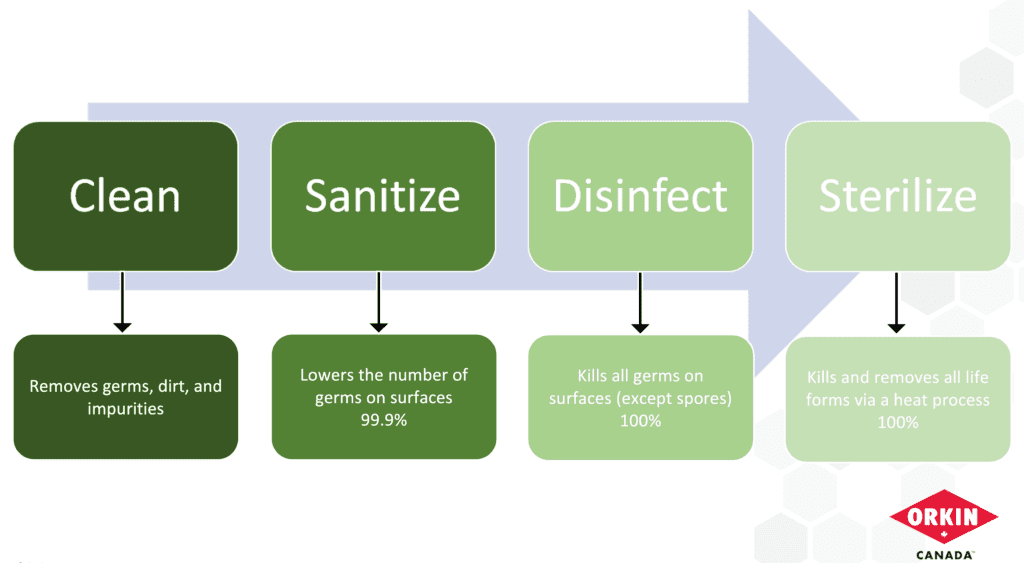During these uncertain times, understanding the differences between a clean environment versus a disinfected one can be crucial. You may have presumed that words such as clean, sanitize, disinfect or sterilize were somewhat the same, or at least interchangeable. However, there are dramatic differences between a surface that is clean compared to a surface that is sterile. Here’s everything you need to know about the differences in cleanliness.
What is the Difference Between Clean vs Sterile?

As we move from clean all the way to sterilize, we increase in cleanliness and we are decreasing the amount of germs, bacteria, and viruses that survive on surfaces.
Understanding the Differences
Cleaning
Cleaning is physically removing germs and dirt and impurities. This is what we would think of when we use soap and water. We’re scrubbing off of the dirt and germs and washing them down the drain. Usually, cleaning is only an option at surface level, as a surface that may appear clean, can still have millions of germs.
Sanitizing
Sanitizing is something that we would associate with hand sanitizer or certain cleaning products. Sanitizing can lower the number of germs on surfaces by up to 99.9%.
Disinfection
Disinfection takes that one level higher and that’s killing germs on surfaces, except for some fungal spores at nearly a 100% rate, it’s actually 99.999%. You might think the difference between 99.9 and 99.999% is not that big of a deal, but when we’re talking about viruses, where there could be millions of virus molecules on a surface leaving behind that 0.099% could mean thousands or hundreds of thousands of virus molecules present on the surface can potentially infect people.
Sterilization
Then we look at sterilization and that is something we typically would associate with medical instruments or dental instruments. Things, such as dental or equipment, that cannot have any living organism on its surface. A sterile surface usually goes through some sort of heating process. Sterilization while very effective is not practical for day to day objects and activities.
When it comes to your role in mitigating transmission of viruses or bacteria, you ideally want to achieve at least disinfection. This is due to the fact that disinfection kills germs on surfaces at almost 100%(99.999%).
If you are looking for more disinfection tips or you need an effective disinfection process for your home or business, Orkin Canada’s team of professional disinfection specialists can help.

You may also like
Canada's Top 25 Bed Bug Cities Of 2023
Bed bugs are extremely efficient hitch hikers. They can move easily across a room and climb onto luggage or anything left on a bed in just one night. Learn which cities have made Canada’s top 25 bed buggiest cities.
British Columbia's Top 20 'Rattiest' Cities 2023
As winter approaches, pest control leader Orkin Canada reminds homeowners and business owners to take precautions to help keep rodents out. Cities are ranked by the number of rodent (rat & mice) treatments the company performed from August 1, 2021 through July 31, 2022.
Ontario's Top 25 "Rattiest" Cities 2023
Pest control leader Orkin Canada reminds home owners and business owners to take precautions to help keep rodents out. Cities are ranked by the number of rodent (rat & mice) treatments the company performed from August 1, 2022 through July 31, 2023. This ranking includes both residential and commercial treatments.
Eastern Canada's Top 15 'Rattiest' Cities 2023
As winter approaches, pest control leader Orkin Canada reminds homeowners and business owners to take precautions to help keep rodents out. Cities are ranked by the number of rodent (rat & mice) treatments the company performed from August 1, 2021 through July 31, 2022.
Remove pests from your home, and stop them from coming back
We work hard to listen, understand and assess your unique situation. Request a free, no-obligation estimate today for a customized pest program that fits your needs.
Request a Free Home EstimateRequest a Free Business Consultation

